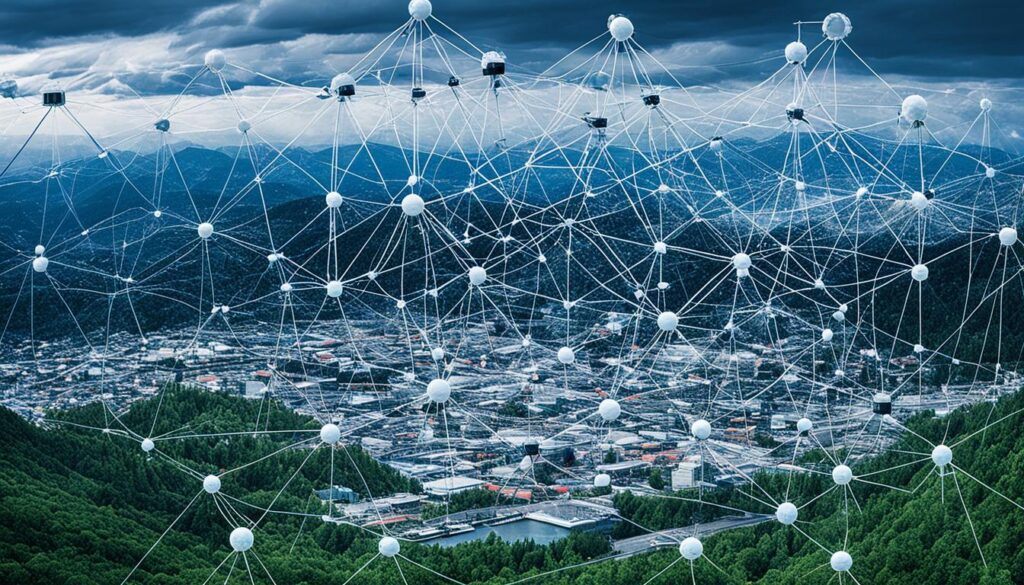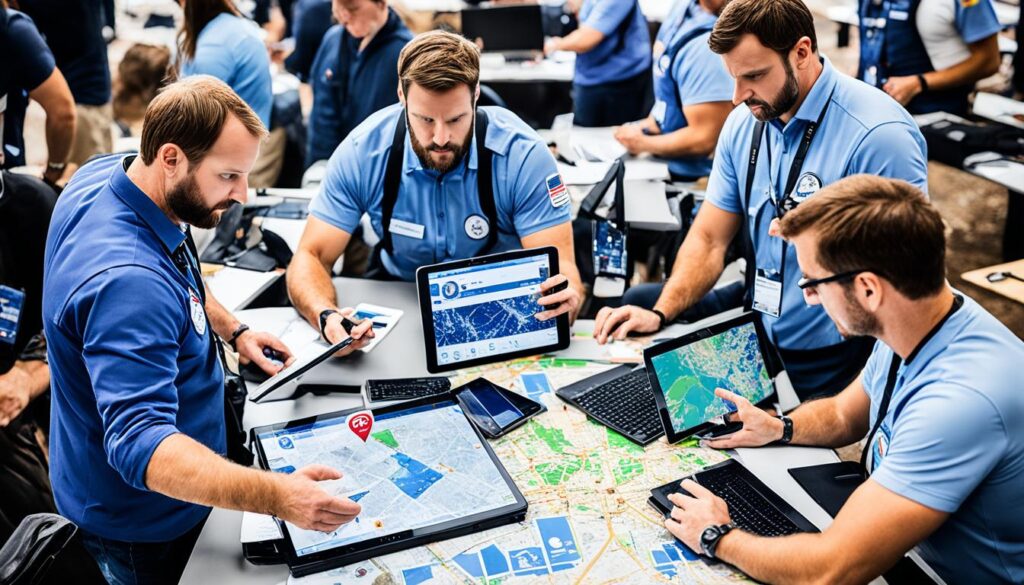Technology has become a key ally in disaster management. It helps with early warnings and real-time communication. These innovations change how we prepare for and recover from disasters.
This article looks at how technology helps in disaster management. It talks about how it helps emergency responders, makes preparedness data-driven, and aids in relief efforts.
Technology uses data and communication to save lives and reduce damage. This article will show how technology changes disaster management. It talks about how it helps with quick communication and awareness, uses big data for predictions, and looks at drones and social media in relief efforts.
With more natural and man-made disasters, technology is key to making us more resilient. This article shows how technology is changing disaster management. It highlights how it’s making communities better prepared to face disasters.
Empowering Emergency Response with Technology
Technology has changed the game for emergency teams in natural disasters and emergencies. It brings new tools like fast communication and real-time data analysis. These tools help teams work better together and react faster to crises.
Rapid Communication and Coordination
New tools for disaster communication let teams share important info fast. This means they can work together quickly and make smart decisions. Mobile apps, platforms, and secure networks help them talk and work together smoothly.
Real-Time Situational Awareness
Advanced tech gives responders a clear view of what’s happening. They get real-time data from sensors, satellites, and people on the ground. This helps them know exactly where to act and how to help best.
Using emergency response tech, teams can work better together, share info fast, and understand situations clearly. This saves lives and lessens the damage from disasters. As tech gets better, so does the ability to help in emergencies.
Leveraging Big Data for Disaster Preparedness
Big data has changed the game in disaster management. It helps disaster experts get ready better and make communities stronger. By using advanced analytics, they can make smart choices and improve emergency plans.
Predictive Modeling and Risk Assessment
Big data and predictive analytics are key to getting ready for disasters. They help teams predict where and when disasters might hit. This lets communities act early and lessen the damage.
With predictive analytics and risk models, we get deep insights into disaster risks. This info helps emergency teams use resources wisely, strengthen key buildings, and plan for emergencies. Being prepared like this helps communities bounce back faster from disasters.
Adding real-time data like weather, earthquakes, and satellite images makes risk assessments more accurate. Disaster teams can spot threats early and warn people, helping them act fast and reduce damage.
Using big data and predictive analytics marks a big change in disaster management. It lets communities prepare, plan, and lessen the effects of disasters. This tech boost makes people safer and communities more resilient.
Technology and Early Warning Systems
Early warning systems powered by advanced technology are key in saving lives during natural disasters. They use sensor networks, satellite images, and real-time data to spot signs of disasters like earthquakes, floods, or severe weather. These systems send out alerts quickly, helping people move to safety and protect themselves.
Sensor networks are a big part of these early warning systems. They watch over many environmental factors, from earthquakes to weather. These sensors send data to be analyzed, looking for signs of danger. When a disaster is spotted, alerts go out fast, helping authorities and people act quickly.

Predictive disaster management technology makes these early warning systems even better. It uses past data, machine learning, and AI to guess when and how big a disaster might be. This lets communities get ready and lessen the damage. It’s all about being proactive in disaster management.
Thanks to disaster alert technology, we can now react faster to emergencies. Communities can make quick decisions to protect themselves. As disasters get more common and intense, these early warning systems are more important than ever. They are a crucial defense against the harm caused by disasters.
Unmanned Aerial Vehicles in Disaster Management
Unmanned Aerial Vehicles (UAVs), or drones, are now key in disaster management. They help with tasks like search and rescue, checking damage from above, and watching disaster areas. These drones are very useful for many important jobs.
Search and Rescue Operations
When disaster hits, every minute counts. Drones are crucial in search and rescue work. They have cameras, thermal sensors, and can gather lots of data. This lets them see the disaster area from above and find people who need help fast.
With drones, search teams can go over tough terrain and reach places that are hard to get to. They can also use their resources better by knowing exactly where they’re needed.
Damage Assessment and Monitoring
After a disaster, knowing how bad the damage is and how things are going is key. Drones help by taking pictures and gathering data from the air. This info helps emergency teams and relief groups make smart choices.
By using drones, teams can see the full picture of the damage. They can spot areas that need help right away. And they can watch how recovery is going, making sure things are getting back to normal.
Adding drones to disaster work has made things much better. These high-tech tools give real-time info and insights. This helps teams work together more smoothly and tackle disaster challenges more effectively.
Technology for Humanitarian Relief Efforts
After disasters, getting aid to those who need it quickly and efficiently is key. New technologies are changing how we help in big ways. They make logistics smoother, increase transparency, and make sure aid gets to the right people fast. This helps save lives and speeds up recovery.
Logistics and Supply Chain Management
Mobile apps, blockchain, and IoT systems are changing how aid groups work during disasters. They track shipments in real-time, find the best routes, and help everyone work together better. This includes aid groups, local officials, and volunteers.
Blockchain keeps track of aid in a safe and clear way. It makes sure no one misuses aid. IoT sensors check on supplies and warn about problems or spoilage. This helps make sure aid is used well.
Thanks to these technologies, disaster relief is getting better at moving aid fast and right. This means people in need get what they need sooner and more effectively.
The Role of Social Media in Disaster Response
Social media has become a key tool in disaster response today. When crises hit, people use platforms like Twitter, Facebook, and Instagram to share updates and ask for help. This lets disaster teams get important info, coordinate rescue efforts, and use digital volunteers to help on the ground.
Crowdsourcing Information and Resources
After a disaster, social media becomes a place to share and find information and resources. People post about the situation, update on affected areas, and ask for help. Disaster teams can use this info to understand the situation better and coordinate their efforts.
They can also connect with digital volunteers to check info, map out affected areas, and link people with resources.
In recent years, social media has been key in disaster response. Platforms like Twitter and Facebook help spread info, coordinate rescues, and rally communities during crises like hurricanes, earthquakes, and wildfires. By using social media, disaster teams can respond faster, use resources better, and get the public involved in recovery.

Technology and Infrastructure Resilience
Extreme weather and disasters are happening more often. Building disaster-resilient infrastructure is now key. Technology helps make critical systems like power grids and transport networks stronger.
Sensors and monitoring systems spot and fix infrastructure problems fast. This helps us respond and recover quicker.
Smart city tech is changing how we handle infrastructure resilience. It uses data to predict and prevent problems. This keeps critical systems running even in crises.
Advanced analytics and predictive modeling find weak spots. They help us focus on protecting the most important infrastructure.
Monitoring infrastructure is vital for resilience. Real-time checks with sensors and analytics warn us early. This leads to quick fixes and less chance of big problems during disasters.
As climate change and new threats grow, technology’s role in infrastructure resilience is more important. With smart city tech, protection for critical infrastructure, and monitoring, we can make communities stronger. They can better handle natural and man-made disasters.
Emerging Technologies for Disaster Management
The way we handle disasters is changing fast, thanks to new technologies. Artificial Intelligence (AI) and Machine Learning (ML) are leading this change. They help predict dangers, make quick decisions, and manage resources smartly.
These technologies look through huge amounts of data to find important patterns. This helps disaster teams get ready for and deal with emergencies better.
Artificial Intelligence and Machine Learning
AI and ML are changing how we tackle disasters. They can quickly go through lots of data from weather forecasts, satellites, and social media. This lets them predict where and when disasters might happen, helping emergency teams plan better.
Machine learning also helps with disaster relief. It looks at how to move supplies and resources to where they’re needed most. This makes disaster relief efforts more efficient, saving more lives.
AI is also being used for search and rescue. Drones with AI can quickly check out disaster areas, find people, and guide rescue teams. This could make disaster response faster and safer, especially in hard-to-reach places.
As disaster management grows, AI and ML will become even more important. They help teams get ready, respond, and recover from disasters better. With these technologies, we can save more lives, reduce damage, and make communities stronger against future disasters.
Challenges and Ethical Considerations in Disaster Technology
Technology is changing how we handle disasters, but it brings new challenges and ethical issues. One big problem is data privacy. When we collect personal info in emergencies, it raises questions about our rights and how to protect our data.
Another big worry is cybersecurity. Using technology in disaster responses makes us more vulnerable to cyber attacks and data breaches. These threats could mess up critical operations. Disaster experts must be careful to use technology safely and responsibly.
Technology has its limits, like infrastructure failures and connectivity issues. We must be aware of these and work to fix them to avoid making things worse in disasters. It’s also important to make sure everyone can use these technologies. Some groups might not have the same access, which could leave them behind.






